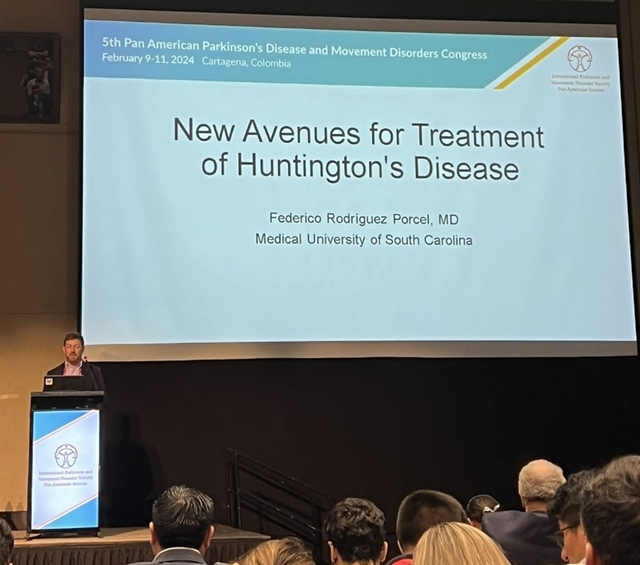 VOLUME 28, ISSUE 1 • March, 2024. Full issue »
VOLUME 28, ISSUE 1 • March, 2024. Full issue »

Insights from the 5th PAS Congress

We had the opportunity to present at the 5th Pan American Parkinson’s Disease and Movement Disorders Congress in Cartagena, Colombia, from February 9 to 11, 2024. The parallel session dedicated to Huntington's disease (HD), moderated by Roberto Weiser (Aruba) and Malco Rossi (Argentina) provided an overview and updates on the genetics, differential diagnoses, and therapeutic innovations in HD.
Emerging Topics in Genetics
The first talk by Prof. Mario Cornejo-Olivas, MD, from Peru highlighted some emerging topics regarding the importance of genetics in Huntington's Disease (HD). It addressed specific features of HD epidemiology in Latin America, including the presence of HD clusters and the necessity for further epidemiological studies to better understand the prevalence of HD in the region.
The genetic aspects of HD were discussed, including the CAG repeat expansion disorder with an autosomal dominant inheritance pattern. It was noted that the (CAG)n repeat expansion within the HTT gene accounts for 60-70% of the variability in age at onset, with penetrance depending on the size of the CAG tract, genetic anticipation, and somatic instability.Additionally, variants such as the loss of interruption variant (LOS) and others related to DNA maintenance and mitochondrial function were identified as genetic modifiers affecting age at onset in HD. Genetic testing for HD relies on estimating the CAG repeat size, which has limitations in sizing.
Genetic counseling was emphasized as essential throughout every stage of HD care, not only for genetic testing purposes, but also for predictive and prenatal testing.
An Update on Phenocopies
Prof. Jose Luiz Pedroso from Brazil described the epidemiology and phenomenology to provide a diagnostic approach to Huntington’s disease phenocopies. Syndromes resembling HD in patients lacking the CAG expansion in HTT gene correspond to around 1% of all cases of Huntington’s disease phenocopy. Although there is no formal definition for Huntington’s disease phenocopies, it has been established as a movement disorder consistent with HD, a negative test for CAG repeat expansion in the gene encoding huntingtin, and at least one of the following features: family history (autosomal dominant inheritance), or cognitive impairment, or behavioral or psychiatric symptoms.1
Although Huntington’s disease phenocopies with a specific diagnosis are rare, the most common causes are HD-like type 2 (HDL2) related to CTG expansion in CTG in JPH3 gene and usually reported in patients from African origin; neuroacanthocytosis (VPS13A gene); dentatorubral-pallidoluysian atrophy (DRPLA) and expansions in the C9orf72 gene. Other unusual forms include spinocerebellar ataxias (mainly SCA2), some forms of neurodegeneration with brain iron accumulation (NBIA), prion diseases (HD-like type 1), and McLeod syndrome.

A diagnostic approach was proposed based on the main clinical features, such as the origin of the family, cognitive impairment, inheritance, age of onset, and presence of epilepsy. Several forms of Huntington’s disease phenocopies are caused by expansions, such as HDL2 and DRPLA, and a specific genetic test or a genetic panel is necessary, while whole exome sequencing can detect point mutations, such as in neuroacanthocytosis.2
New Avenues of Treatment
Prof. Federico Rodriguez Porcel from the US discussed the current status of treatment options for Huntington's disease and future avenues.
Currently, treatments for symptomatic therapy exist, including the use of VMAT2 inhibitors and therapy. Recently, the FDA approved the use of Valbenazine for the treatment of chorea based on the results from the KINECT-HD trial.3 Ongoing trials are focusing on other HD symptom domains, such as cognition and gait, using other treatment avenues beyond pharmacological therapies, such as neurostimulation and stem cell transplant.4 Currently, there is no disease-modifying treatment for HD.
The main focus of the therapy development has been decreasing the production of mutant Huntingtin (mHTT), which is assumed to be pathogenic. The use of antisense oligonucleotides (ASO) was received with significant excitement after the results from the Phase 1b/2a study showing that Tominersen could lower the levels of mHTT, only to be followed with disappointment after the Phase 3 study was halted due to lack of benefit and worsening atrophy.5 However, further analysis suggested that a lower dose, in a younger, less symptomatic group may provide benefit. This has been the basis for the current ongoing trial GENERATION-HD 2.4 Other specific ASOs are currently being evaluated for safety and efficacy.

Besides ASOs, other targets to decrease mHTT being evaluated in trials include gene therapy and splicing modulator approaches.6 Other disease-modifying strategies beyond mHTT lowering with ongoing trials or under development include DNA repair therapeutics and targeting the immune response.6
The current wealth and variety of initiatives to tackle disease modification in HD bring sincere optimism to the community.
References
1. Wild EJ, Tabrizi SJ. Huntington's disease phenocopy syndromes. Curr Opin Neurol 2007; 20(6): 681-7.
2. Schneider SA, Bhatia KP. Huntington's disease look-alikes. Handb Clin Neurol 2011; 100: 101-12.
3. Furr Stimming E, Claassen DO, Kayson E, et al. Safety and efficacy of valbenazine for the treatment of chorea associated with Huntington's disease (KINECT-HD): a phase 3, randomised, double-blind, placebo-controlled trial. Lancet Neurol 2023; 22(6): 494-504.
4. Estevez-Fraga C, Tabrizi SJ, Wild EJ. Huntington's Disease Clinical Trials Corner: August 2023. J Huntingtons Dis 2023; 12(2): 169-85.
5. Tabrizi SJ, Leavitt BR, Landwehrmeyer GB, et al. Targeting Huntingtin Expression in Patients with Huntington's Disease. N Engl J Med 2019; 380(24): 2307-16.
6. Tabrizi SJ, Estevez-Fraga C, van Roon-Mom WMC, et al. Potential disease-modifying therapies for Huntington's disease: lessons learned and future opportunities. Lancet Neurol 2022; 21(7): 645-58.
Read more Moving Along:






